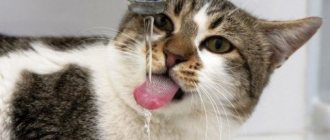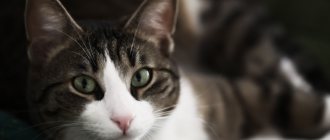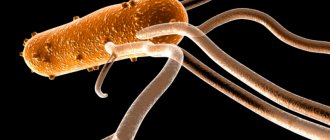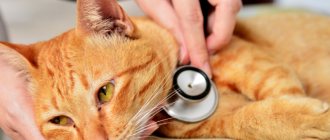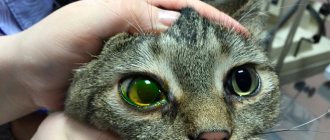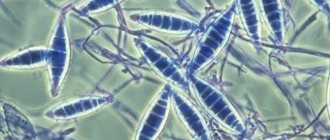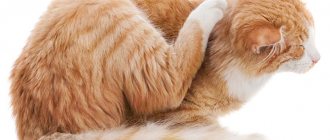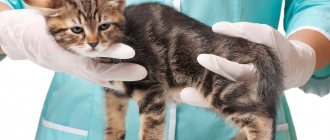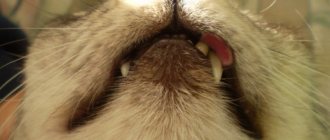Prevalence of CKD
Chronic kidney disease (CKD) is one of the most common diseases in cats, affecting up to 35% of older cats1-5 and up to 10% of all cats seen in veterinary clinics.6-8 FEDIAF (European Feed Industry Federation) estimates pets), in Europe alone, approximately 9 million cats were affected as of 2010.9 As the cat population is gradually aging, CKD in cats is expected to become the predominant disease over time.
Pathophysiology
The main function of the kidneys is to constantly filter the blood and excrete urea and other metabolic products, while preventing the loss of water and electrolytes. The structural and functional unit of the kidneys that performs this important function is the nephron (Fig. 1). An indicator of the effectiveness of the kidney filter is the glomerular filtration rate (GFR).
Rice. 1. Functional anatomy of the kidneys; nephron structure
The kidneys perform a number of other important functions in the body, including:
- Maintaining optimal blood pressure
- Maintaining calcium and phosphate levels in the body
- Maintaining a normal number of red blood cells (RBC) in the blood.
In many cases, in cats with this pathology, there is a progressive decrease in the glomerular filtration rate up to azotemia (i.e., an increase in the level of nitrogen-containing substances such as urea and creatinine in the blood), which develops when more than 75% of functioning nephrons die. 13
In cats, CKD is considered a spontaneously progressive disease because, once renal function declines to a certain level, progressive nephron death persists even after the underlying pathology has resolved. Most treatments for CKD in cats are aimed at suppressing the maladaptive mechanisms responsible for the spontaneous progression of the disease.11-13
Diagnostic tests
The most effective way to identify kidney problems is to visit your veterinarian regularly. Routine examination is recommended for adults starting from the age of six. Starting from the age of 8, it is recommended to do this more than once a year.
Cat with a catheter
Kidney failure can be diagnosed using blood and urine tests. An ultrasound examination is recommended. The veterinarian makes a diagnosis not only based on information received from the cat’s owner, but also after the results of laboratory tests.
The most important is the partial or complete absence of urine excretion. Also, during the examination, attention is paid to the presence of the smell of urine in the animal’s breath, pallor of the mucous membranes, and low body temperature.
For your information! A sign that the kidneys are failing should be considered an increased level of urea and creatinine in the blood, since they are the main indicator of the organ’s performance. The level of acidity and phosphorus in the blood is also checked. Urine is examined for the presence of protein, glucose and renal epithelium. In some cases, a kidney biopsy may be needed.
Glomerular hypertension and disease progression
In cats with chronic kidney disease, as the number of functioning nephrons decreases to maintain total glomerular filtration rate (GFR), the GFR of the remaining normal nephrons increases. This process is complemented by vasoconstriction of the efferent glomerular arterioles, which results in an increase in intraglomerular pressure and, as a consequence, GFR. In addition, as the number of functioning nephrons decreases, there is an increase in blood flow velocity and hyperperfusion of the remaining nephrons.
Despite the fact that these compensatory mechanisms are aimed at maintaining overall GFR, the resulting glomerular hypertension leads to an increased load on the remaining nephrons and an increase in the rate of their destruction. Glomerular hypertension is also accompanied by an increase in the severity of proteinuria. This creates a vicious circle in which there is continuous death of nephrons and deterioration of kidney function (Fig. 2).
Rice. 2. Vicious circle in CKD in cats
Symptoms of end-organ damage secondary to hypertension may be the first signs of disease that owners and veterinarians notice in cats with CKD. These include:
- Hemorrhages or loss of vision in one or both eyes
- Behavior change
- Ataxia
- Cramps (sometimes)
Diet for the treatment of chronic renal failure
Following a diet for chronic renal failure is an important stage of treatment and is subsequently required to maintain the health of the cat and prolong its life. Since irreversible changes occur in the kidneys during chronic renal failure, the animal urgently needs a specialized diet.
After detoxification has been carried out, blood pressure and electrolyte balance have been adjusted, the protein load on the kidneys should be reduced, since in the chronic course of the disease they cannot cope with the removal of protein breakdown products. To maintain the correct dietary intake, veterinarians advise giving the animal medicinal foods of the kidney series, "Khlis", "Purina" and "Ekanuba".
Renin-angiotensin-aldosterone system (RAAS) and CKD
The renin-angiotensin-aldosterone system, or RAAS, is a sequence of hormonal reactions aimed at maintaining blood pressure within a narrow normal range. Strict blood pressure control is achieved by maintaining a balance between the following processes:
- Vasoconstriction
- Vasodilation
- Control of extracellular fluid volume and blood volume by excretion or retention of sodium and water.
Angiotensin II is the active end product of a cascade of hormonal reactions. It binds to angiotensin II receptors on the surface of cells in various tissues and causes various biological effects, which are depicted in Fig. 3.
Rice. 3. Renin-angiotensin-aldosterone system (RAAS) and its effect on homeostasis
Clinical manifestations of CKD in cats
Cats with CKD exhibit a wide variety of nonspecific clinical manifestations. It is important to remember that the clinical manifestations of CKD are related to loss of renal function and not to damage to the kidneys themselves.11-13
The most common clinical manifestations of CKD in cats are:
- Primary polyuria (PU)
- Compensatory polydipsia (CP)
- Lack of appetite
- Weight loss
- Lethargy
Other clinical manifestations include gastrointestinal symptoms such as intermittent vomiting, constipation and halitosis.
Symptoms of chronic renal failure: Differences between chronic renal failure and acute renal failure
Often, symptoms of chronic renal failure in cats are either absent or minimal. With decompensation or during the decompensation period, the animal may notice lethargy, lack of appetite, constant thirst, excessive urination and rapid weight loss. Also a sign of the development of chronic renal failure may be the rapid formation of tartar, the appearance of gingivitis and stomatitis. A severe clinical picture is observed at the final stage in the terminal period. To prevent this, you should contact your veterinarian at the first suspicion of the development of pathology.
The acute form also has no characteristic symptoms, but if you carefully monitor your pet, it can be identified. To prevent it from leading to dire consequences and developing into an irreversible stage, you need to consult a doctor in a timely manner and begin treatment.
Chronic renal failure differs from acute:
- development of anemia;
- smooth onset and long course;
- absence of pain on palpation of the kidneys;
- blurred clinical picture.
Based on the symptoms, it is quite difficult to understand which form of renal failure is developing in the animal, so at the slightest suspicion of the disease, you should definitely visit a veterinarian with your cat.
Prognosis of CKD in cats
As a rule, CKD in cats is characterized by a slowly progressive course and irreversible degenerative processes; This pathology has a high level of morbidity and mortality. If left untreated, CKD is a common cause of death or euthanasia in cats.19
Rice. 4. Cats with mild to moderate CKD die from kidney failure in 57% of cases. 19;
CKD = chronic kidney disease; CVD = cardiovascular disease
Causes of development of chronic renal failure
CRF develops against the background of disruption of the organs of the excretory system, or, more precisely, due to:
- frequent inflammatory pathologies due to improper therapy or an incomplete course;
- delay in the development of one of the kidneys;
- lesions of the zona glomerulosa;
- genetic predisposition to the disease;
- congenital pathologies;
- renal polycystic disease;
- bacterial infections;
- tumor processes leading to disruption of the functioning of the excretory system.
Also, advanced acute stage of renal failure can lead to the development of chronic renal failure.
Anamnesis
Typically, CKD is found in cats over 6-7 years of age2 and is most common in cats over 10 years of age (>35%).22 The following clinical manifestations occur:
- polyuria
- polydipsia
- anorexia
- loss of appetite
- vomit
- weight loss
- lethargy
- halitosis (bad breath)
In some cases, the first signs of the disease are manifestations of hypertension, such as vision loss or ataxia.
Diagnosis and treatment
Let's figure out how to save an animal if we find signs of kidney failure in a cat.
First of all, do not take independent measures to treat your pet - immediately take the cat to the vet. a clinic where a professional doctor will prescribe the necessary treatment regimen. The diagnosis is made based on the following data:
Ultrasound
- A blood test showing the presence of inflammation in the body, as well as determining the concentration of urea, creatine, phosphorus and other trace elements indicating the fact of PN in the animal;
- A urine test showing the density of the fluid, the concentration of toxins, protein, bacteria, traces of blood and kidney cells.
- X-ray of the kidneys;
- Ultrasound;
- Anamnesis - collection of general information about the animal by interviewing its owner;
- Blood pressure indicators;
- Kidney biopsy, etc.;
It must be remembered that chronic renal failure cannot be cured - this process can only be slowed down by maintaining the functioning of the cat’s kidneys in proper condition through a special diet and preventive measures.
The method of treating chronic renal failure in cats is selected according to the stages of the disease and may consist of the following measures:
- Droppers to restore electrolyte balance;
- Erythropoietin (a hormone produced in the kidneys) and vitamin B12 intravenously;
- Drugs that neutralize hypertension;
- A balanced diet with plenty of fluids and low protein and phosphates;
- Reducing the level of phosphorus and potassium in the blood through drugs;
- Decreased acidity in the body;
- Restoration and control of urine formation;
Important! All drugs for the treatment of chronic renal failure in cats should be prescribed exclusively by a doctor, taking into account all the data on the pet’s illness. Self-medication in this case is fraught with sad consequences.
IV
Analysis of urine
Simultaneous testing of urine and blood samples is an important step in the diagnosis of CKD in cats and is increasingly used in practice in Europe. Among the studied indicators, the most frequently assessed is the relative density of urine (RUD); Some cats with CKD have isosthenuria, with TPR ranging from 1.007 to 1.015.23-25 Urine testing can identify other pathological changes that occur in cats with CKD, such as proteinuria or concomitant urinary tract infection (UTI).
A new era in the treatment of CKD in cats
The relevance of RAAS blockade in the treatment of CKD.
Typically, medications that block the effects of the RAAS are used to treat CKD in cats. As a result of blockade of the RAAS, there is a predominant expansion of the efferent glomerular arterioles, a decrease in intraglomerular pressure and, as a consequence, a decrease in the severity of proteinuria. Reducing proteinuria in cats with CKD is important because:
- Even with low protein concentrations, proteinuria is a poor prognostic sign for survival in feline CKD 28,29
- As the severity of proteinuria increases, the risk of death increases26
Other undesirable effects of angiotensin II and aldosterone (on the heart and kidneys) can also be reduced by blocking the RAAS.30-34
Angiotensin receptor blockers (ARBs) are a new class of pharmaceutical drugs for veterinary use developed to reverse the adverse effects of angiotensin II and aldosterone.
What are angiotensin receptor blockers (ARBs)? Angiotensin receptor antagonists or blockers (ARBs) are a class of molecules that directly bind to angiotensin II receptors, in contrast to angiotensin-converting enzyme inhibitors (ACEIs), which block the angiotensin-converting enzyme (ACE) (Figure 6).
Rice. 6. Diagram illustrating the targeted mechanism of action of ARBs
There are two main types of angiotensin II receptors: AT1 and AT2. Most of the functions of angiotensin II are mediated by AT1 receptors.35 These receptors are found in the blood vessels, kidneys, liver, heart, adrenal gland and pituitary gland. AT2 receptors appear to slow the body's response to angiotensin II, and many of the effects of AT2 receptors are opposite to those of AT1 receptors.
How are ARBs different from ACEIs?
Due to their targeting of specific receptors18,36,37, ARBs have two obvious advantages over ACEIs :
1) targeted mechanism of action: the effect is directed only at AT1 receptors, through which most of the adverse effects of angiotensin II are mediated in conditions of impaired renal function (Fig. 7). The beneficial effects of AT2 receptor activation are maintained.35
Rice. 7. Diagram illustrating the benefits of selective blockade of AT1 receptors
2) ARBs such as telmisartan (Semintra®) directly and selectively block AT1 receptors and do not inhibit ACE.35 In response to inhibition of enzymatic activity during the hormonal cascade, the necessary enzymes are bypassed. In response to inhibition of ACE, which originates from the renin-angiotensin-aldosterone system, the formation of “tissue ACE” increases, which catalyzes the synthesis of angiotensin II, despite the maximum suppression of ACE. This phenomenon is known as “ACE escape” and has been observed in many mammalian species with long-term use of ACE inhibitors35 (Figure 8).
Rice. 8. Schematic representation of the phenomenon of “ACE escape”
This phenomenon is also typical for cats receiving ACE inhibitors (for example, for the treatment of heart disease).18,38-41 When using ARBs, “ACE escape” does not occur; the clinical results of drugs in this group are associated with a direct effect on AT1 receptors and with the blockade of adverse effects of angiotensin II.
Preventive actions
It is best to prevent the development of chronic renal failure than to then undergo complex and not always effective treatment for this disease. By following the recommendations below, the cat owner will be able to minimize the risk of disease:
- safety precautions must be observed. The cat must be protected from injury, poisoning and self-medication of various diseases must be avoided;
- when diagnosing urolithiasis, the animal must be treated exclusively in the clinic;
- infectious diseases of the urinary system should be diagnosed and treated in a timely manner;
- It is necessary to ensure that your pet does not gain excess weight.
You must also strictly adhere to the doctor’s recommendations if the animal is diabetic, since diabetes can cause the development of chronic renal failure.
Semintra for the treatment of CKD in cats
Semintra® (active ingredient: telmisartan) is the first angiotensin receptor blocker (ARB) registered for use in veterinary medicine*.
(*State register of veterinary medicines as of 03/01/2018)
The drug is specially designed for use in cats:
- Semintra® is designed to reduce proteinuria in chronic kidney disease (CKD) in cats36
- Semintra® contains the active molecule telmisartan, an angiotensin receptor blocker (ARB), and has a targeted mechanism of action
- in most cases, Semintra® in the form of an oral solution was well accepted.37,42
